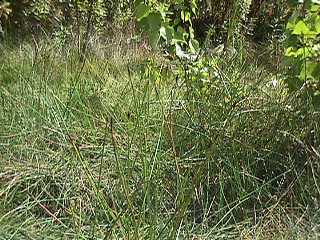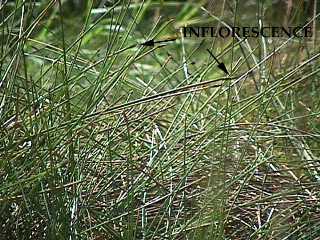

General Species Description
- Creeping spike-rush is the largest of the three common spike-rushes and grows ten to one hundred centimeters tall. Stems are dark green, erect, round, sometimes tufted, and arise from small branching underground rhizomes. Spike-rush should also be recognized to be a native perennial. As an aside, 'creeping spike-rush' refers to the plants'spreading rhizomes and not to its stems.
Leaves
- Although the creeping spike-rush appears to lack leaves, they are actually present, modified as small, thin, and dark reddish sheaths that tightly girdle the base of the stems.
Inflorescence/Flowers
- On the creeping spike-rush, the tips hold the lance-shaped spike (about five to twenty-five millimeters long.) and containing forty to one hundred flowers per spike. Each spike is enclosed by individual, scaly bracts.
Fruits
- The achene is lens-shaped, yellow to medium brown, smooth with a long (0.4-0.7millimeter.) spear-shaped tubercle. The creeping spike-rush seeds from May through August.
Habitat
- The creeping spike-rush is common in wet prairies, vernal pools, wet meadows, ditches, fields, and pastures. Creeping spike-rushes often grow in mud along the margins of pools and streams.
Range
- Creeping spike rushes are a common species found throughout the are of the Pacific Northwest.
Similar Species
- Needle spike-rush (Eleocharis acicularis) the smallest of the three common spike-rushes in our area, is densely tufted, a distinguishing feature from the Eleocharis palustris. The ovate spike-rush (Eleocharis obtusa) is an annual of intermediate size and its flowers head is more oval then the creeping spike-rush.
Ecological Value
- The cluster of seeds in the spike of the creeping spike-rush provides food for various species of ducks and geese. Also the stems provide nesting for various birds. The roots of the creeping spike-rush are eaten by mammals.
Human Value
- These particular plants provide effective erosion control on banks when plant populations are dense.
References
- Cooke, S. S. ed. 1997. A Field Guide to the Common Wetland Plants of Western Washington and Northwest Oregon. Seattle Audubon Society and Washington Native Plant Society. Seattle Audubon Society, Seattle WA, 292 pp. Guard, B. Jennifer. 1995. Wetland Plants of Oregon and Washington. Lone Star Publishing, Richmond, WA. 162. Hitchcock, C. L. and A. Cronquist. 1973. Flora of the Pacific Northwest. University of Washington Press, Seattle, WA. 64 pp.
This page was created by: Laura Nash, August 1998
Return to Northwest Oregon Wetland Plants Project